Lunch with... Johnny Herbert & Damon Hill
Brilliant sportsmen both, who formed two parts of the most talented group of their generation. But are they now really Formula 1’s answer to Ant & Dec? Damien Smith finds out
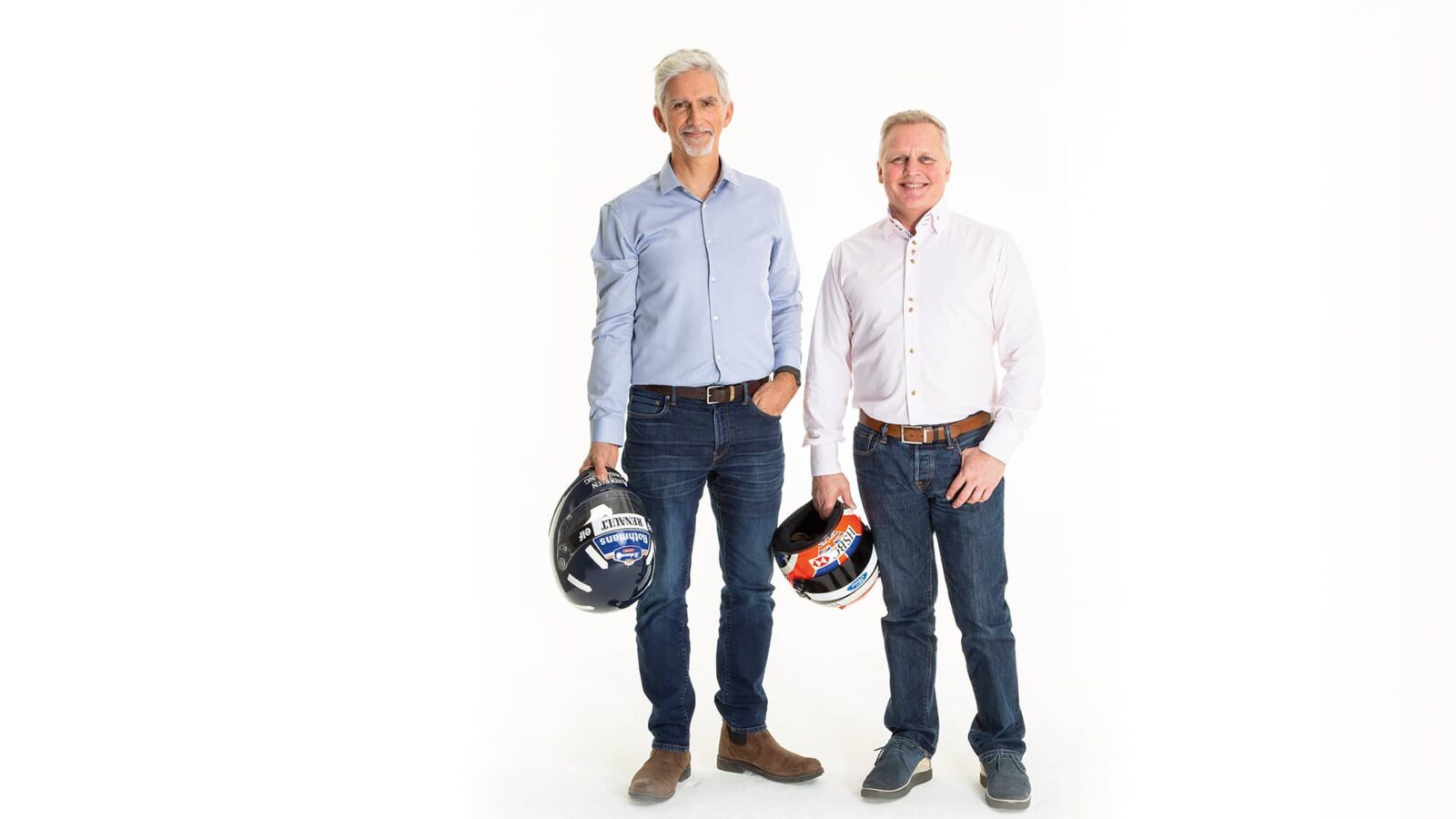
Paul Marc Mitchell
Dumb and dumber. That’s how Sky Formula 1 presenter Simon Lazenby once chose to refer to our guests for lunch this month. The question is, which one is which? Let’s find out!
Johnny Herbert and Damon Hill have been friends for 35 years and counting, dating all the way back to their Formula Ford days when they first sized each other up as rivals on motor racing’s devilishly slippery nursery slopes. Such bonds forged during lives and careers that became interwoven have led to a natural chemistry that Sky has tapped into as part of its F1 TV coverage. They have become something of a double-act on the box – “F1’s answer to Ant & Dec” as they describe it – and have gained a reputation for, let’s say, the lighter moments of race broadcasts. It’s not that they don’t take media work seriously – heaven forbid – but with a shared 261 grand prix starts behind them, not to mention 25 wins and one drivers’ world championship, they’re at a stage where they don’t take F1 life too seriously – or at least most of it. “The pressure is off for us now,” as Damon puts it. “We’re lucky, we’ve made it through the tough bit.”
Off the back of the TV double-act, the duo have now decided to produce a book together that takes a light-hearted poke at the sport both of them love. The clichéd title Lights Out Full Throttle gives you some clue to the tone they set, as does the sub-head, The good, the Bad and the Bernie of Formula 1. Ba-doom! But while there’s plenty of fun and self-deprecating mickey taking, there’s inevitably plenty of thought-provoking insight from two vastly experienced and respected aces. Hill has just turned 60, Herbert is happy to lag behind on this one at 54. They recorded their chats with ghost writer James Hogg in a 15th-century Elizabethan house by a roaring log fire, before the world was spun off its axis. Cosy. Certainly more than our conversation conducted over Zoom. Each, of course, has dined with us before, without the other, Hill in 2007, Herbert in 2008. And with career stories that are both branded into motor-sport lore, we’ve chosen to take a leaf from their book and skip around some themes. Inevitably the lunch involves much mirth, many chuckles (mostly from Herbert) and, like the forthcoming book, some tasty nuggets.
Speaking of nuggets, their choice of lunch is suitably lowbrow. Damon goes for a peanut butter and jam sandwich, Johnny for a wrap: “Turkey and Emmental cheese stuffed in a microwave. Warm it up, get it out, stick some humous on top, roll it up, quick and easy.”
“Stick it in the bin and have a packet of crisps,” fires back Hill. “You know me so well!” giggles Johnny. This could be a long lunch.
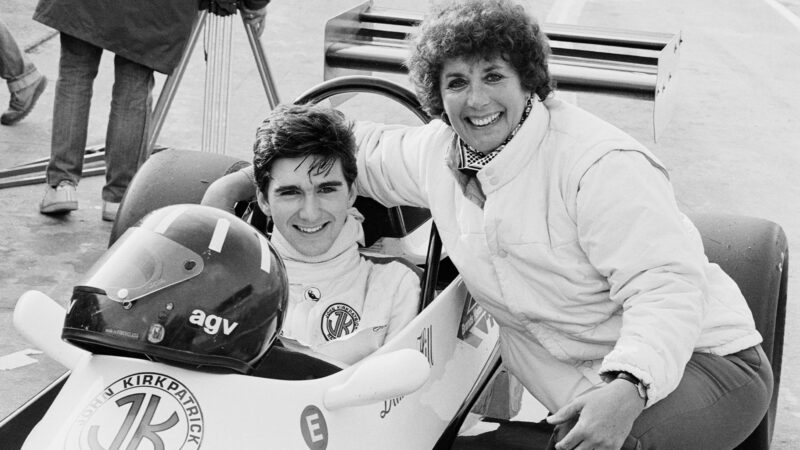
Damon Hill’s introduction to car racing was a learning curve. Here he is preparing for Formula Ford 2000 Winter Series action in 1983, with his mother Bette alongside
So how did they meet? “All I know is I’ve got a picture of Johnny kissing my wife when we were all very young, in 1984,” says Damon. Johnny remembers it (no surprise there). Last time we lunched, Herbert suggested he was a little more serious in his youth, although Damon almost chokes on his peanut butter at the suggestion. “Serious? No, not really,” admits Johnny. “But I was shy and that sometimes came across in an arrogant way. When we had fun away from the track that wasn’t the case. I knew of Damon when he raced motorbikes, so I was aware of him. Then you did the Formula Ford 2000 winter series.”
“Yes, at the end of 1983,” says Damon. “Everybody knew because it was on News at Ten… and I was this sad kid who’d be thrown in this boiling pot of Formula Ford 2000 with Martin Donnelly. I was totally out of my depth.”
Herbert admits he held some negative preconceptions about his future mate, the son of a late and much-missed double world champion. “I thought at the time he was just living off Graham: coming into the sport, using the name, getting sponsorship to go motor racing,” says Johnny. “How wrong was I. That definitely wasn’t the case. He had to fight all the way through his career. I thought he had the silver spoon, but that wasn’t the way. Good on you, matey.”
“I can understand you thinking that,” says Damon. “I came from bikes, but I was a fish out of water because I think they all thought I should be in cars! I would turn up in my van and speak with my very nice public-school accent and they’d think, ‘You’ve got the wrong sport, mate.’ Then when I ended up in cars I had to get to know all these guys and find out who’s the opposition. And here was this chap Johnny Herbert, he’s skipping around with golden locks and everyone thinks he’s wonderful. This was the guy to beat. But he completely wiped the floor with us at the Formula Ford Festival in 1985, coming from the back, and showed us what he’d got. After that I was chasing his tail.”
The pair were part of the ‘Brat Pack’, a gifted generation of British racing talent, their in-it-together bond away from the tracks not a million miles from the band-of-brothers comradeship Graham Hill enjoyed with Jim Clark, Jackie Stewart and the rest during the 1960s. Mark Blundell, Martin Donnelly, Julian Bailey and Perry McCarthy would all make it to F1, too – just, in the case of the latter. “We were quite lucky when we were doing F3,” says Damon. “There wasn’t the pressure the guys today are under. We had an opportunity to go and race all over Europe and really enjoy ourselves doing what we loved. I don’t see that around so much now. They are controlled in every single direction they operate, although someone like Lando Norris and others like Daniel Ricciardo have the attitude that this has got to be fun. That’s good.”
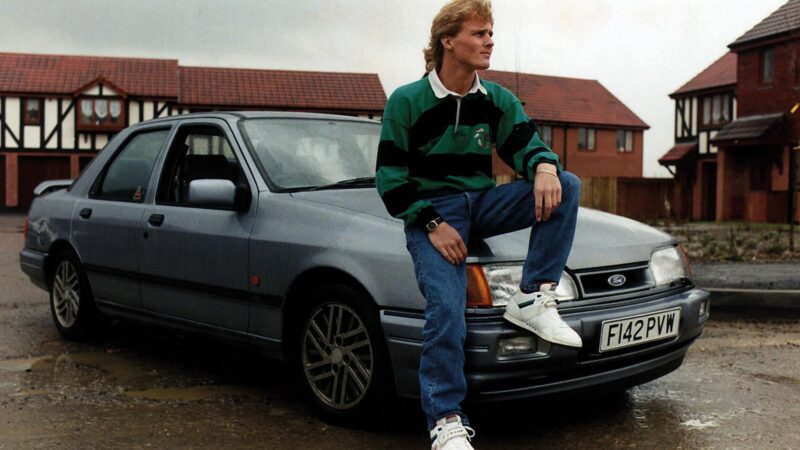
The looks and locks of a superstar: Johnny Herbert was a standout racer on F1’s junior slopes
“We had fun,” agrees Johnny. “But once we got on the track it was a different scenario. Damon doesn’t get the credit he deserves because I’d been karting from 10 years old and got into cars when I was 19. Mark had competed in motocross and scrambling. But Damon hadn’t got any background apart from his bit of bike racing – except his dad was an F1 world champion. He had to learn very quickly at a more mature age, because he didn’t have that experience. But even in 1985 at the [Formula Ford] Festival final, it was Jonathan Bancroft on pole position, Damon Hill in the middle and me third. So even there you could see this raw talent. He says he was trying to work out who his competitors were – he was one for me. He was always there, always consistent. When you raced against him I suppose in the early days I could outfox him, but that changed. He developed very quickly. But the fun factor was important as well and the most important thing was the respect between us all.”
“We bonded in Formula Ford and then we went to F3, bumbling along together,” says Damon, who spent three years in British F3, first with Murray Taylor followed by two seasons with Intersport, learning to win when he could and finishing third in the championship in 1988. By that time Herbert was already in Formula 3000, having blazed to the British F3 title for Eddie Jordan in ’87. “We were being attacked all the time by Brazilian drivers who would turn up with a lot of fire power,” says Damon, “so there was a sense of feeding off each other, looking at the others and thinking, ‘I know I can beat him. Therefore I’m ready for Formula 3000.’”
Herbert made it to F1 first, just seven months after the F3000 accident at Brands Hatch that almost cost him a foot. He knows, Damon knows, we all know, it changed everything for a man some tipped as Britain’s new Jim Clark. Benetton team manager Peter Collins, long convinced of Herbert’s potential, kept the faith and signed him for 1989 at a time when Johnny could barely walk. The fairy-tale fourth place in Rio, only a little more than 10 seconds down on winner Nigel Mansell, remains one of the great F1 debuts, especially given the state of Herbert’s terribly mangled feet. But by July Johnny was out, sacked by doubting new boss Flavio Briatore in the wake of a string of poor results. Herbert has long admitted he can’t blame the Italian retail specialist for making the call.
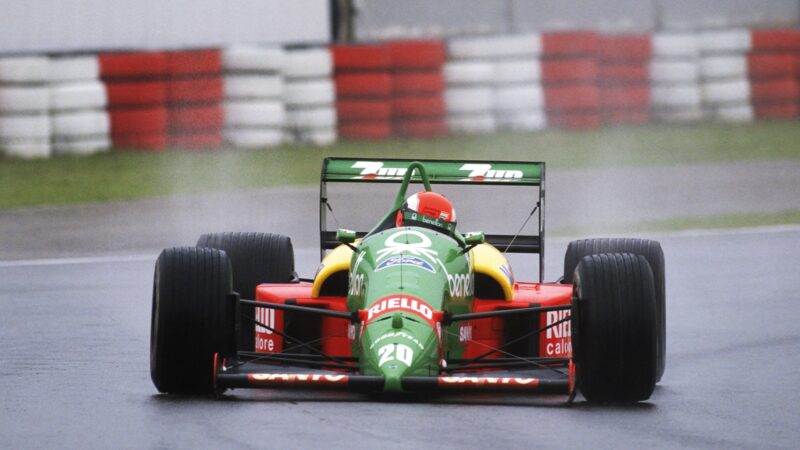
Herbert got his Formula 1 break with Benetton in 1989, but found coping with his injuries tough
Those painful months, both physically and psychologically, lead us to the expectations placed on drivers. Those on Herbert changed dramatically before and after his accident, while Hill faced a series of different pressures wrought from being the son of a famous father to landing the best F1 seat on the grid on little more than his dependability as a test driver.
Johnny first. “Everything I’d gone through after my accident and then getting my chance in F1, all the issues I was having on the track… I always tried to put it all in a box, put it to the back of my mind,” he says. “I couldn’t speak to my wife; I for sure couldn’t speak to Flavio Briatore. I always had to do things in a secret way, and then deal with everything else that goes on in the F1 paddock, the expectations and pressures. My feet were very painful at every single grand prix, usually with about 15 laps to go. Also I didn’t have the same feel and touch I’d had before, again something I couldn’t discuss with anyone. So I dealt with two separate things. One, how I got around driving the car and the pain I had probably in 95 per cent of the races. Second, what everyone deals with: the racing itself, trying to get results and stay in a team or move on. But that’s life. It was unfortunate what happened to me at Brands Hatch. I was lucky I even had a career, to be perfectly honest. I was fortunate that I was in that era, that I had Peter Collins who helped get me into Benetton and later into Lotus. If it happened today I would not have had a career in F1, and very possibly even in sports cars. If I look back, I did do a good job. But in my head it was always about winning races and being world champion. I won three races” – two on his second spell at Benetton in 1995, one for Stewart at a rain-affected Nürburgring in 1999 – “but I’d wanted the world championship since I was 11 or 12 years old. Didn’t happen, but hey: I didn’t have a bad one considering.”
For the only time in our conversation, the laughter has stopped. “There was no doubting his talent,” says Damon. “That’s the hard bit for Johnny. Clearly he had the talent to be a world champion, he might have been a multiple world champion. He still had fantastic performances, but we’re mindful of how the element of luck has played in our careers.”
For Herbert, he would live with a new expectation for the rest of his long career following the shunt: was he really up to it? “Damon did F3000 and got a lot of pole positions, but was very unlucky and didn’t get the wins he deserved,” says Johnny. “So I always thought that when he got his chance at Brabham and then Williams he was always having to prove himself. Because of his dad he always had to try and impress people, and so was I, but because of the injury. I thought people would look at me and say, ‘He’s damaged goods.’ The only way I could change that was by getting results. The fourth place in Rio was very important. Even today people still remember it. But when I was up against Mika [Häkkinen] at Lotus it was all about me trying to beat him because he was the new golden boy coming through. Whoever your team-mate is and wherever you are on the grid, that is what you have to do. But because of my injuries I felt I was having to prove myself in the cockpit. One of the most important races I ever did was Le Mans in 1991” – which he won driving the banshee-like Mazda 787B, sharing with Bertrand Gachot and Volker Weidler – “because it was a tough 24-hour race I thought I could then take it to the following F1 race and say, ‘There you go, I can do that. I’m OK.’”
“At least people thought you were the greatest thing since sliced bread at one time in your career!” interjects Damon, puncturing the serious bubble. “I don’t think anybody thought that of me at any time in my career.”
“That was a stab at me, wasn’t it?”
“Stop moaning about it! It’s only your feet!” Hill’s F1 story is and always will be among the best of any driver, not simply because of the astonishing chain of events, but also because of the intense, slightly vulnerable, complex nature of the character at its centre. How he went from a Brabham that finished four laps down on Mansell’s winning Williams at Silverstone in 1992 into Nigel’s seat for the next year, beside Alain Prost; finding himself paired with Ayrton Senna for 1994, only for the fastest driver of his generation to die at their third race as team-mates; how Hill then stepped up, just as his father had done at Lotus in ’68 in the wake of Clark’s death… and found himself facing a new force, the like of which had never been seen before. With hindsight, we now know Damon was facing statistically – at least at the time of writing – the greatest racing driver there has ever been. Schumacher.
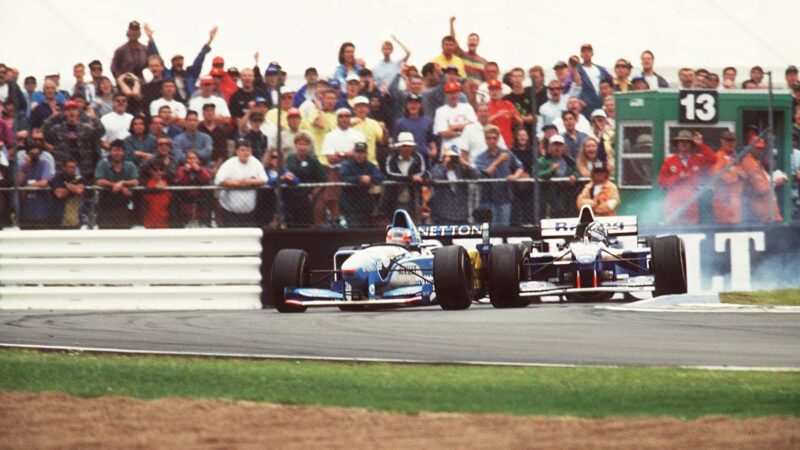
The best of enemies? Hill’s Williams collides with Schumacher’s Benetton at Silverstone in 1995
“Ayrton was bemused by Michael,” he says. “Who was this guy? Ayrton was the top dog, Alain had retired and he was supposedly undisputed. Then along comes Michael – this was a new thing. He had no regard, no respect for who was there. It was a bit of a shock. We didn’t realise he would go on to win more championships than anyone. I was one of his first victims, I always think. It was tough. But if you are in a team like Williams, which was used to winning, I couldn’t jump out of the car and say, ‘D’you know, he’s really good! He’s going to become the greatest of all time!’”
That 1994 season was one of turmoil. Beyond the shock and bereavement for Roland Ratzenberger and Ayrton Senna, the season was pock-marked by knee-jerk rules changes and a series of disqualifications and bans for F1’s apparently arrogant new wunderkind. That Schumacher won his first title with a notorious professional foul on Hill in Adelaide was bad enough, but his success was earned within a thick fog of doubt about the legality of his Benetton – a fog that still hasn’t lifted, to the exasperation and annoyance of Rory Byrne and Pat Symonds, both of whom nearly walked away from F1 disenchanted in the wake of the unproven allegations. Early that season, Senna was convinced Schumacher’s car was running traction control, which had been banned ahead of the new season. Today, what does Damon think? Was he beaten by a driver in a bent car?
“Zoom time is up!” says Damon with a grin, then pauses before giving a considered answer. “There were a lot of people who were thinking, ‘What the hell are they up to?’ There was in our mind the idea that Benetton were doing tricks of some sort, and that may have been self-defeating in some respects, because we needed to not think like that. But the fact of the matter is they did get disqualified from races for certain things they did. They were prepared to do quite a lot to push the boundaries. I don’t think that is in dispute.”
Herbert found himself parachuted into Benetton at the end of the season, just over five years after the team had dropped him, as the steam ran out of Team Lotus. After one race for Ligier, which Briatore had just bought, he ran the final two races of ’94 as Schumacher’s team-mate and then raced on for a full season in ’95. Suddenly like his friend, Johnny was in an A-list seat in which he would win first the British GP – after Damon had helpfully taken out Schumacher while fighting for the lead – and then the Italian GP at Monza. The expectations had ramped up, but so too had Herbert’s. His experience beside Schumacher remains a bitter-sweet memory.
“I suppose the biggest difference I saw from Lotus to Benetton was Ross [Brawn] and Pat, their strengths and experience, plus the work ethic they had with Michael,” he says. “They had total belief that he was the best, and they would do anything and everything to give him what he needed. I was dragged in at the end of ’94 for the constructors’ championship [which Williams won], but overall 1995 was a similar thing. The focus was on one driver.
“It’s frustrating when I look back, but it’s understandable why Flavio wanted to give Michael everything because he handed it back with those two world championships. Then you see the strength with Ross on strategy and the organisation that he had within the team in the engineering room. And then there was Pat and the relationship and understanding he had with Michael. Then you throw Rory Byrne into that mix. They all understood what he needed and they were very good at supplying it, which isn’t easy. Look at Ferrari today. You know what you need to do, but supplying it is another matter.”
Symonds has always poured cold water on Herbert’s claim that he was ostracised at Benetton, while maintaining a fondness for his old driver – how can you be cross at him? But
Johnny remains adamant that he felt pushed to the periphery. “Any driver who does their own negotiations for a contract knows the team principal will always tell you what their expectations are, but there’s also what comes back to you as a support mechanism,” he says. “When we were negotiating it was all about ‘we’re one team, we need to work together, it’s important to get the constructors’ title, so we need to be able to give you what you need’. Before the second race weekend had finished that had all evaporated. The focus was all on Michael. That was very difficult mentally, and this is where Damon had the strength after Ayrton’s crash. I probably didn’t deal with it very well, but then I didn’t have anyone to talk to in the team. Sometimes when the data was shown to me it was in the corner of my eye, as the meeting was going on. That’s not how this thing should work. On the other side of the table [Michael] was looking at his own data, but also mine at the same time. Their expectations were still the same, but they were not giving me what they promised.”
“Johnny, you could have always asked me for help,” cuts in his partner once more. “‘Damon, what does this squiggly line mean? Help me beat Michael Schumacher!’”
“Mr Hill, there were times when we were walking down the paddock, I’d see you going one way and I’d be going the other and I’d say, ‘Morning Damon,’ and you’d blank me and go straight off,” Johnny chuckles.
“Sorry. Don’t take it personally. My mum always used to say lift your head up, look where you are going, because I always used to walk along looking at the ground.”
Hill always was an introvert at the tracks with a pressure-cooker intensity, in stark contrast to his sunny friend. In the book, they discuss self-belief and Hill talks about a session with an American sports psychologist, Mary Spillane, that changed his outlook and helped improve his state of mind after his poor season in 1995. He credits the session as a major contributor to his world championship in 1996.
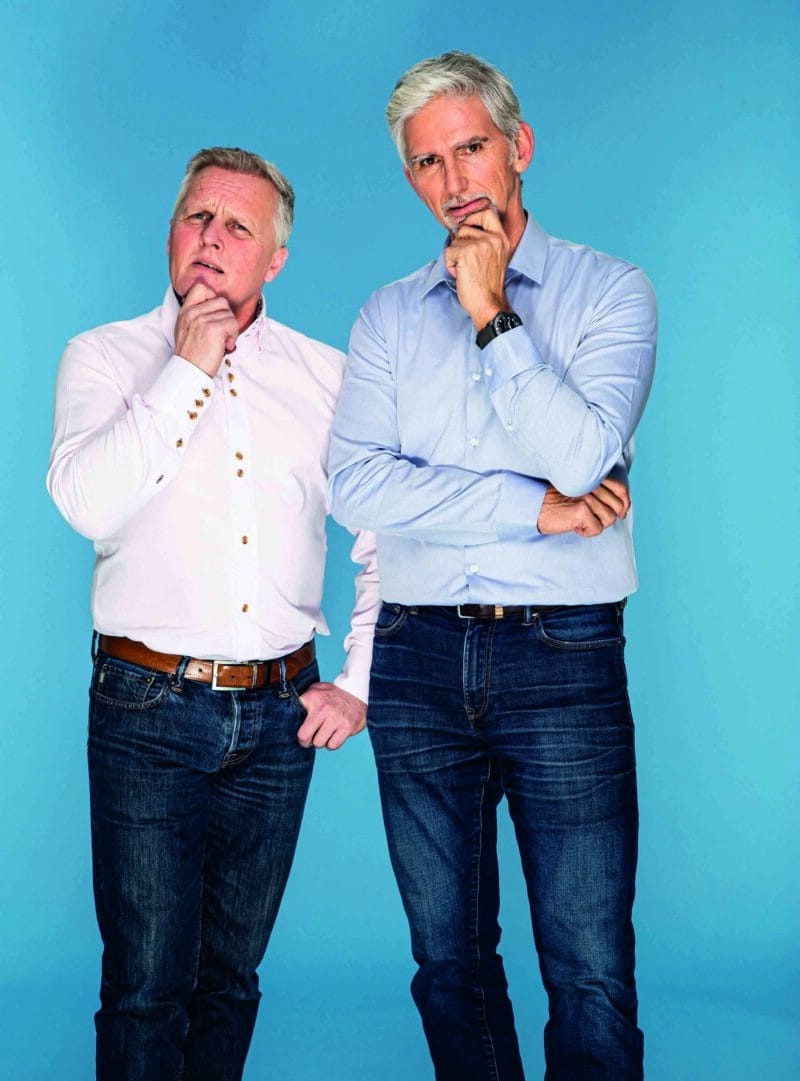
Ant & Dec or Dumb and Dumber? As pairs go Hill and Herbert are finding their own broadcasting niche… and wear their achievements lightly
“When top sports people go to see a sports psychologist what they notice is how people who are very good at what they do are highly self-critical,” says Damon. “They don’t doubt themselves, they always believe, but they want to know why something specific didn’t work, how can I get more? They are always looking to strengthen up their weak points. I don’t think you can go into this with real doubts because otherwise you wouldn’t do it. What you’ve got is questions about how far you can go with what you’ve got, and given a bit more, how much further could you go. You are looking for gains all the time, and I’m sure that goes for every driver. They all believe they can be Lewis Hamilton, if they just have a little bit more of this, that or the other.”
The reference turns the conversation to Britain’s six-time world champion. Both Hill and Herbert profess a genuine respect for Hamilton. Criticism and what’s best described as pure hatred on social media is something neither had to face during their own careers. “It’s a good thing they didn’t have Twitter when I crashed into Michael at Silverstone in 1995!” points out Damon. As Hamilton approaches Schumacher’s win and championship records, Hill offers a fascinating comparison, not to his old rival but to another past master. “Even when he’s off the boil he’s as good as anyone,” he says. “Spa this year was ridiculous: he turned Spa into a go-kart track. Now he’s matured as well, so he’s got the confidence and knowledge which makes him stronger than he has ever been. I was thinking about Fangio, who negotiated to get the best car and then to be number one in each team. You think maybe being 38 [his age when he travelled to Europe to begin his grand prix career] he was able to do that more than if he’d been 20 years old. Lewis is at a stage where he can see which way the wind blows and can make his own choices.”
There’s a sizeable portion of public opinion that has no time for Hamilton’s campaigning against racism. Were Hill and Herbert on the grid today, it seems they’d have no second thoughts about taking the knee. The general perception is motor sport doesn’t have a racism problem, which is why there was surprise and not a little anger when Hamilton challenged that position. “When Lewis talks about racism, how do we know?” says Damon. “We’re white. We have no experience what that is like in a predominantly white environment when you are black. The other thing is, with sport and politics, I think there comes a point when great champions find a cause to fight for, like Muhammad Ali did. Ayrton was passionate about helping underprivileged children. Great sports people find they have this talent and feel they have to use it for something else. Lewis has that motivation. In some ways he’s now got a reason to demolish everyone, because now there’s a point to it all. Otherwise it’s a very selfish thing to do, to win everything.”
Their media roles in the paddock have kept them close to the F1 coalface. Would they swap their time to race in this one? “For me, no,” says Johnny. “The challenge I liked was driving between the white lines, knowing there was the kerb, grass and a gravel trap and if you got it wrong you were going to pay some form of penalty. Now on the circuits as they are that’s not really the case.”
Damon’s response offers a characteristic snap shot of the strong-willed independence that drove him through his career. “I wouldn’t want to be told about how to drive by the engineers,” he says. “Something grates about that. I want to know information, but to be told ‘stay here, don’t go too fast’, that doesn’t feel right. Doesn’t a racing driver choose a direction and go their own path? The guys before my era usually went against their parents’ wishes to race. They didn’t take instructions from anyone.”
Pity any producer trying to cajole Damon Hill into any TV stunt he doesn’t want to do. Dumb and Dumber? Don’t believe everything you see and hear on the telly.
Waking the dread
How Herbert poked a wasp’s nest with his pranks
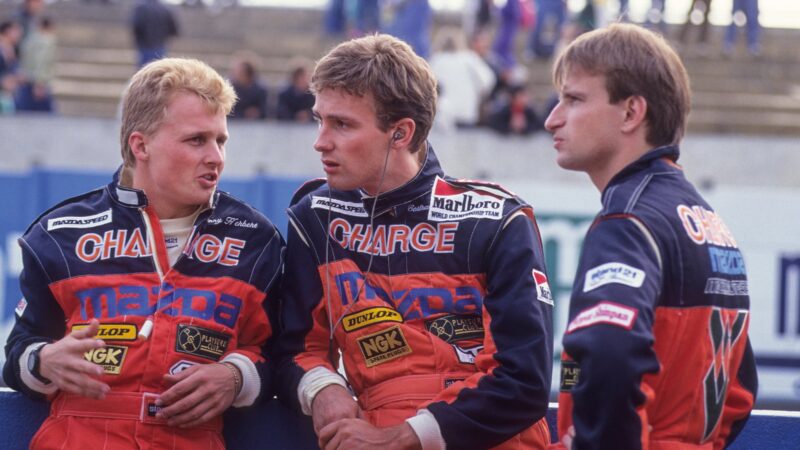
Herbert (left) chats with Gachot as Volker Weidler watches on
When Johnny Herbert first did Le Mans as partner to single-seater rival Bertrand Gachot in 1990, a year before their famous win, he played a practical joke on the fiery Belgian that could have left him with new injuries beyond his damaged feet. In the new book, Johnny explains how, after he’d retired their car from the race, he realised Gachot was still sleeping in their quarters. So what did he do? He burst in, shouting at his partner that he was late for his stint, that the team was going spare. Gachot woke in a blind panic, then realised the truth when he spotted a creased-up Herbert on the floor. The man who would spray CS gas at a London cabbie a year later in a traffic dispute, earning himself a jail term that cost him his Jordan F1 drive, was less than amused.
“When I see him now I still mention it and he does laugh,” says Johnny. “He didn’t at the time, I think he wanted to kill me.” But Johnny, of all the drivers to poke… “Yeah, I know! I still try and do it today when I see him. Nothing has changed.”
“He’s a lovely bloke,” pitches in Damon. “I had a fantastic time talking to him when we shared a flight coming back from southern Spain where he lives, talking about old times. He went through a lot, including going to jail. Life has got many twists and turns, but a lot of our group from those days made it to F1.”
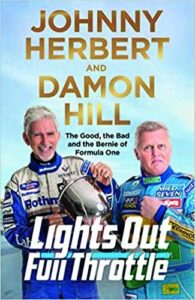
Lights out, Full Throttle by Damon Hill and Johnny Herbert is published by Pan Macmillan on October 15.
Buy your copy from the Motor Sport shop
